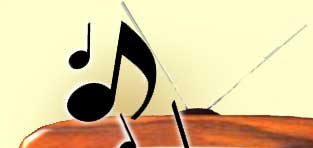 |
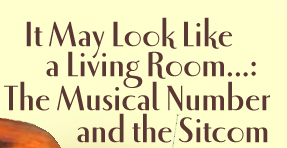 |
 |
|
 |
|

- As film musicals fade from popularity, the musical number fades from
the sitcom as well—at least in the narrative form we saw in I
Love Lucy and The Dick Van Dyke Show. The cataclysmic
changes in popular music from the mid–1950s were partly responsible
for both trends. Rock and roll was the biggest revolution in popular
music in thirty years, a revolution that, like jazz before it, was charged
with racial and sexual challenges to the mainstream norm, particularly
the white suburban domesticity fostered by the sitcom. But whereas jazz
had only the gramophone and the print media to document its emergence
into pop culture, the advent of rock and roll coincided with the availability
of cheap record players and 45-rpm singles, a boom in AM radio stations,
and, of course, television. Indeed, it is an oft-asserted truism that
the collusion of television and rock and roll killed the musical (in
reality, it probably had more to do with the demise of the studio system,
but that, too, was affected by television).
- The first sitcom to really embrace the new music did so, ironically,
from within its domestic setup. The Adventures of Ozzie and Harriet
was, like I Love Lucy and The Burns and Allen Show,
based around a real-life showbiz family, bandleader Ozzie Nelson, his
singer-wife Harriet (Harmon) Nelson, and their two sons, David and
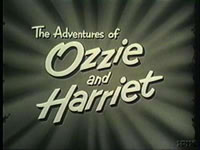 Ricky.
Unlike the other sitcoms, however, the Nelson family stressed the
family,
not the show; in fact, one really never knew what Ozzie did for a living,
though one strongly suspected that Ozzie the television father was
not
Ozzie the bandleader. When young Ricky took up music, like millions
of other American boys, it became part of the show. Ricky Nelson
was
not merely another pretty-faced teen idol, but perhaps one of the underrated
icons of early rock and roll, fitting somewhere between Elvis Presley
and the Everly Brothers in his rockabilly profile. With his sweet face
and clean-cut image, he brought rock and roll to a mainstream audience
in as non-threatening a guise as possible, while also paving the way
for other teen idols (most notably Paul Petersen of The Donna
Reed Show) to parley television success into record success—a
path consequently trod by others including John Travolta (Welcome
Back, Kotter), Brandy (Moesha), and Will Smith (The
Fresh Prince of Bel-Air).26 The
teen idol became a safety valve between the adult mainstream
world of
the sitcom and the rebellious youth world of rock and roll. It became
such a cliché that when Roseanne did a parodic
version of a 1950s sitcom, the son DJ (nicknamed “The
Deej” in an
homage to Leave It to Beaver) left the football team in order
to play “the rock and roll music,” much to the consternation
of his father—revisiting with a satirical slant the concerns
over normative gender roles in 1950s sitcoms.
Ricky.
Unlike the other sitcoms, however, the Nelson family stressed the
family,
not the show; in fact, one really never knew what Ozzie did for a living,
though one strongly suspected that Ozzie the television father was
not
Ozzie the bandleader. When young Ricky took up music, like millions
of other American boys, it became part of the show. Ricky Nelson
was
not merely another pretty-faced teen idol, but perhaps one of the underrated
icons of early rock and roll, fitting somewhere between Elvis Presley
and the Everly Brothers in his rockabilly profile. With his sweet face
and clean-cut image, he brought rock and roll to a mainstream audience
in as non-threatening a guise as possible, while also paving the way
for other teen idols (most notably Paul Petersen of The Donna
Reed Show) to parley television success into record success—a
path consequently trod by others including John Travolta (Welcome
Back, Kotter), Brandy (Moesha), and Will Smith (The
Fresh Prince of Bel-Air).26 The
teen idol became a safety valve between the adult mainstream
world of
the sitcom and the rebellious youth world of rock and roll. It became
such a cliché that when Roseanne did a parodic
version of a 1950s sitcom, the son DJ (nicknamed “The
Deej” in an
homage to Leave It to Beaver) left the football team in order
to play “the rock and roll music,” much to the consternation
of his father—revisiting with a satirical slant the concerns
over normative gender roles in 1950s sitcoms.
- The teen idol was also a point of contact between television and
the charts: after the initial upheaval of rock and roll, after Elvis
Presley was drafted, Buddy Holly and Ritchie Valens were killed, and
Chuck Berry sent to prison, there was a space in the late 1950s and
early 1960s where pop music was dominated by teen idols like Frankie
Avalon, Paul Anka, and Fabian, and the last gasp of Tin Pan Alley, symbolized
by the Brill Building, Motown, and the girl groups. Popular music was
a highly contested space in the 1960s—more than is generally acknowledged
by pop historians who tend to dwell on one side of the musical divide
or the other, and who perpetuate the myth that once rock and roll arrived,
there was a complete capitulation. In fact, for over a decade, the charts
remained split between the styles generally favored by adults and those
of the younger generation. As sitcoms aimed for a broad mainstream audience,
this lack of consensus only discouraged writers and producers further.
The wide variety of music on The Dick Van Dyke Show would have
only just been acceptable to the adult, white, middle-class mainstream,
and, as we have seen, the show worked rather hard to make sure of this.
-
What happened to the musical number in the 1960s and the 1970s? Whereas I have discussed the musical number in I Love Lucy and The Dick Van Dyke Show as narrative suspensions or disruptions, they are still integrated into the narrative—Ricky stages a show at the club that Lucy wants to get into, or there is a a troublesome guest star or skit on The Alan Brady Show. The connection may, at times, be rather tenuous, but the number still carries some narrative weight. What tends to happen later is that the musical number returns to a state closer to that of the variety show—or even the “removable” musical number common in classic-era movie musicals, in which African-American artists performed songs and dances that were designed to be entertaining and popular, but which could be safely removed in racist markets without harming the narrative flow. Often, these musical numbers were predicated not on narrative necessity or even interest, but either as an opportunity to give the actors a chance to display talents not normally called upon, or to highlight guest stars.27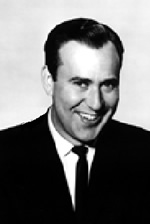 Alan Brady
Alan Brady
- The former was how The Brady Bunch transformed from a sitcom
(1969–74) to a variety show (1977). It started with a “talent
show” that was so popular that musical performances began to be
dropped into the show with increasing regularity. Three years after
its cancellation, the show was briefly revived as The Brady Bunch
Hour. It was not successful, commercially or generically, as TVTome
comments:
The premise of “The Brady Bunch Hour” is hard to understand. The Brady family was chosen to star in a variety show on ABC. They left their familiar two story home somewhere in southern California for a place on the beach. (The first installment had a completely different living room set from both the rest of the installments and the original series.) The series includes not only “the variety show on ABC,” but also the behind-the-scenes doings of the Bradys as they go about making their variety series. There were also some sketches which were more or less a continuation of the original “Brady Bunch” episodes and which had nothing to do with the “ABC variety series.” Unfortunately, the seams between the two modes are not clear, and this results in continuity errors such as Rip Taylor playing a character named Jack Merrill on the variety show, but the Bradys also know him as Mr. Merrill when they’re not on TV, and the Bradys announce him as “our own Rip Taylor” in the opening and closing. It is not always clear what the Bradys are doing or what audience they are playing to.
Including guest stars was the main mode for musical performance in Happy Days (1974–84), which looked back to the “let’s play rock and roll” mode of the 1950s by having the boys form a band that occasionally played at Arnold’s hamburger joint where Fonzie even danced once. But the most memorable performances were by glam-rocker Suzi Quatro as “Leather Tuscadero and the Suedes.” Marking a kind of middle ground between showcasing cast members’ talent and including guest stars, one of the co-stars of the Happy Days spin-off Laverne & Shirley (1976–83) was MGM musicals veteran Betty Garrett, who had been in such classics as Take Me Out to the Ballgame (1948) and On the Town (1949) paired with Frank Sinatra. Despite her talent, Garrett did not perform musical numbers on Laverne & Shirley while most of the performance was by a secondary character Carmine “The Big Ragu” Ragusa (Eddie Mekka).
- In none of these cases was the musical number really an integral
part of the show’s identity—even when people think of The
Brady Bunch, it is much more about the trials and tribulations
of the kids, although the tacky-glitz of the costumes and the upbeat
performance styles are sometimes referenced. And in the case of two
shows which are more remembered for their music than their stories—The
Monkees (1966–68) and The Partridge Family (1970–74)—the
musical number was even more resolutely outside the narrative.
- As its ABC Friday timeslot-mate The Brady Bunch came to
be, The Partridge Family was about a performing family. (Even
at the age of eight or nine, I can remember being aware as a viewer
that The Brady Bunch’s increasing reliance on musical
performance was responding to the popularity of The Partridge Family.)
Both these families were reflective of a different kind of family than
was the norm in sitcoms, but that were increasingly common in American
society: the Bradys were a blended family, Shirley Partridge was a single mom. In some ways, The Partridge Family re-oriented the old show-musical trajectory of couple- formation to family-formation, at least in the pilot episode. At the beginning, the mother is shown to be somewhat unaware of the ambitions of her music-making children; when she joins the group at the last minute, she is integrated with them, and at least partly becomes “one of the kids.” It is in music that they are closest as a family, but the numbers exist primarily as adjuncts to the narrative. Only very rarely do the songs relate to the narrative, and then only obliquely. They do not further the plots, and are often edited in such a way that they are not even as integral as the living-room performances at the Petries. At most, they might be the end-point of an adventurous trip, or the reason the family finds itself at a certain location. On a couple of occasions, they perform for charity events after being moved by the plight of those whom they meet on their travels, but this is not usually the case.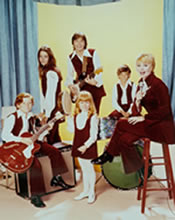 The Partridge Family
The Partridge Family
- The Monkees was an attempt to capitalize on the popularity
of the Beatles’ frenetic film A Hard Day’s Night
(Richard Lester, 1964—that film also owes a significant debt to
silent film comedies and Gene Kelly and Stanley Donen’s film version
of On the Town (1949)). The Monkees’ narratives
were silly and fantastical, but even at that, the musical numbers were
completely unrelated to what was happening. Occasionally, they were
even shifted from one episode to another. They were simply islands of
music and quick-cut editing that prefigured the independent music video.
- Musical numbers did not disappear. Indeed, they may seem more prominent if only because they do not blend into the fabric of the narrative. Ironically, via music video and innovative dramas, the musical number has made an integrated return to the sitcom, though at a different conceptual point.
- The integrated musical number re-emerged in television during the
1980s, a period in which the generations again reached
a sort of consensus on popular music. Concurrently, the rise of music
video and the increased use of popular music in film made music in sitcoms
and other television programs more acceptable, as genre boundaries were
crossed and re-crossed with ever-increasing self-reflexivity.28
Although not sitcoms per se, Michael Mann’s Miami Vice
(1984–89) and Glenn Gordon Caron’s Moonlighting
(1985–89) were particularly instrumental in bringing the musical
number back into television (and indeed, even into film), though in
different ways. Miami Vice took the music video style and applied
it to narrative, with quick editing accelerating classical montage technique,
and music commenting on, or even in dialogue with, the drama (see
Stilwell “’In the Air Tonight’” for examples).
The music was almost exclusively non-diegetic, giving it a narrative
power often reserved for the omniscient voice-over narrator—both
occupy a god-like conceptual space, overseeing the action in all times
and spaces. Non-diegetic underscore also unites time and space across
editing, but the presence of the semantic content of song lyrics in
underscore makes the non-diegetic song far more “present”
or “heard,” to riff on Claudia Gorbman’s
influential title, than instrumental underscore.29
Moonlighting, although like Miami Vice an hour-long
show, was very similar to a sitcom in its style and pacing and used
musical performance as one way of breaking the “fourth wall,”
a significant feature of the show. Characters, particularly David Addison
(Bruce Willis), would confront the camera and comment upon the action,
the characters, or even the show’s timeslot. The postmodern play
of reference that flooded the show’s dialogue was often also musical,
from brief lyric references to a full-blown mock-Gilbert & Sullivan
operetta number in a prisonyard (“Cool Hand Dave”).30
Between them, these two shows exploded conventions about the way music
could be used in television, thereby reshaping the use of music in sitcoms
as well. They had some technological advantages over the sitcom in that
they were normally shot on film and edited like movies, as opposed to
the multi-camera, live-audience shoots of the average sitcom, but they
also opened up new possibilities. Building on this influence, different
sitcoms incorporated music in increasingly varied ways.
- The musical numbers in The Cosby Show (1984–92) were
not normally intended to be funny. They were performing more serious
cultural work, introducing and reinforcing a sense of African-American
history and accomplishment. Jazz legends were literally brought into
the family as grandparents or other relatives; cast members were given
the opportunity to display their talents, usually without irony. They
were narratively uncomplicated, presented as performance and meant to
be appreciated as such. They are the closest to The Partridge Family
mode of framing a musical number, although the famous lip-synching of
“Night Time is the Right Time” by the entire Huxtable family
bears traces of The Dick Van Dyke Show’s living room
performances.
- Slightly more self-conscious are the occasional numbers in The
Nanny (1993–99). For the first couple of years, this sitcom
set in the home of a producer of Broadway musicals was surprisingly
music-less. Butler Niles (Daniel Davis) proves to be a proficient singer
(“What the Butler Sung”), but more often it is the antics
of nanny Fran Fine (Fran Drescher) that result in musical numbers that
verge on the chaotic. The resemblance of this situation to that of I
Love Lucy passes no one by, not least the writers and performers
of The Nanny, as references to the earlier show come in Fran’s
exaggerated cry or Mr. Sheffield’s (the Broadway producer, head
of house-hold, played by Charles Shaughnessy) Cuban-
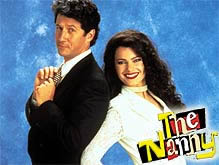 accented
call, “Miss Fine! You’ve got some ’splainin’
to do!” Nostalgia shades over into postmodern reference in the
most obvious way, while highlighting a shift in gender and class roles.
It is Niles who really “wants to get in the show” (he has
written a play that he wants Max Sheffield to produce and often slips
it into his boss’s pile of scripts), but Max often counters by
telling or demonstrating to Niles how much he needs him to keep his
house—it is Niles who is also trapped in a stifling domesticity.
As the series progressed, the ambiguous gender-positioning of Niles
is frequently the source of comedy, from his wearing of a frilly apron
and carrying a feather duster (the classic “French maid”
outfit) to his desire to see Fran’s union with Max. He is both
girlfriend (or gay friend) and mother figure to Fran, a domestic “wife”
to Max, and eventually sexually paired with spinster socialite CC, a
tall, statuesque blonde whom he often taunts about her “masculinity,”
crossing class boundaries in a way more often associated with women—marrying
up.
accented
call, “Miss Fine! You’ve got some ’splainin’
to do!” Nostalgia shades over into postmodern reference in the
most obvious way, while highlighting a shift in gender and class roles.
It is Niles who really “wants to get in the show” (he has
written a play that he wants Max Sheffield to produce and often slips
it into his boss’s pile of scripts), but Max often counters by
telling or demonstrating to Niles how much he needs him to keep his
house—it is Niles who is also trapped in a stifling domesticity.
As the series progressed, the ambiguous gender-positioning of Niles
is frequently the source of comedy, from his wearing of a frilly apron
and carrying a feather duster (the classic “French maid”
outfit) to his desire to see Fran’s union with Max. He is both
girlfriend (or gay friend) and mother figure to Fran, a domestic “wife”
to Max, and eventually sexually paired with spinster socialite CC, a
tall, statuesque blonde whom he often taunts about her “masculinity,”
crossing class boundaries in a way more often associated with women—marrying
up.
- In most sitcoms of the 1980s and 1990s, the musical number’s
function migrated from the gag as narrative disruption to the gag as
generic disruption. Neale and Eaton argue that audience recognition
of the play with generic conventions is often indispensable to the functioning
of comedy narrative (see Neale “Psychoanalysis” and Eaton
“Laughter”). After such a long absence, the presence of
a musical number in the narrative confines of a familiar genre like
the sitcom transgresses genre-boundaries in a way that provokes comedy,
giving lie to Eaton’s assertion that “ … whilst comedy
can be directed against anything, it cannot be analytical of anything”
(“Laughter” 25). For do we not, on some level, have to analyze
the conventions in order to recognize their transgressions?

- The musical numbers in Perfect Strangers (1986–93)
are the most transparent example of the musical number functioning as
comedy sheerly on the disjunctive quality of its insertion into the
narrative.31 The format of the series
is conservative in the extreme, an age-old tale of the innocent set
adrift in the cold, cruel world with the assistance of an only slightly
more worldly character who suffers under the delusion that he knows
what he is doing; the innocent is always the savior. The musical numbers
are continually initiated by the innocent Balki (Bronson Pinchot), who,
through infectious enthusiasm and/or dogged insistence, drags his down-to-earth
American cousin Larry (Mark Linn-Baker) into performing with him. Unlike
Lucy (as opposed to Lucille Ball), Balki and Larry and Pinchot
and Linn-Baker are accomplished singers and dancers; the numbers are
performed to a high standard—they are not slapstick. The comedy
stems from the unrealistically unworldly Balki’s encyclopedic
knowledge of popular culture, also the innocent incongruity of breaking
into song and dance in the middle of a living room, or a workplace,
frequently with harmonies and complex choreography that clearly require
previous devising and rehearsal.
- Demonstrating even more dramatically the disruptive possibility of
a musical number is an early episode of Murphy Brown (1988–98)
in which a gunman takes the fictional FYI television news team
hostage. The gunman disrupts the “narrative” of their broadcast,
i
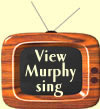 n
effect subverting their narrative with his own, but after several abortive
attempts to regain control of the situation, the team inadvertently
discovers an unlikely manner of neutralizing the situation. The number
becomes increasingly complex and fluent, until the gunman screams at
them in frustration to shut up. Their musical performance disrupts his
“narrative” of control. While this number seems to emerge
“naturally” from the situation (even though, in real terms,
it is obviously carefully staged), it nonetheless also disrupts a narrative
trajectory, albeit one internal to the overarching narrative of the
episode.
n
effect subverting their narrative with his own, but after several abortive
attempts to regain control of the situation, the team inadvertently
discovers an unlikely manner of neutralizing the situation. The number
becomes increasingly complex and fluent, until the gunman screams at
them in frustration to shut up. Their musical performance disrupts his
“narrative” of control. While this number seems to emerge
“naturally” from the situation (even though, in real terms,
it is obviously carefully staged), it nonetheless also disrupts a narrative
trajectory, albeit one internal to the overarching narrative of the
episode.
- In more overtly satirical shows like The Simpsons
(1989–present; another example of a sitcom that developed out
of a recurring skit from a variety show, The Tracey Ullmann Show
(1987–90)), or Third Rock from the Sun (1996–2001),
the musical number falls somewhere between a Brechtian distancing
and
sheer surface play.32 The Simpsons’
musical numbers may be parodies (“Springfield, Springfield”
rather than “New York, New York,” including the misplaced
accentuation inherent in the transposition) or pastiches, but they
tend
to be framed like classical musical numbers. In Third Rock from
the Sun, they are much more disruptive, narrative non sequiturs,
or hyperbolic reactions: when Dick finds out that Mary likes show
tunes,
he instigates a choral rendition of “Oklahoma!” in a snowed-in
truck stop where the song’s originator, musical theater legend
John Raitt, “happens”
to be present; the cast breaks into an impromptu Riverdance parody
after emerging from a performance of “King of the Jig;” the
aliens find themselves helpless in the face of Eddy Grant’s “Electric
Avenue,” as it compels their human bodies to get funky. Then
there are the dream sequences in the 3-D episode “Nightmare
on Dick Street,” which convince the aliens that they are losing
their minds because they have never experienced dreams before. Likewise,
the
distinctive and frequent musical numbers in The Drew Carey Show
(1995–present) operate almost always as fantasies—one of
the very oldest type of musical number. However, the very fact that
song and dance are there at all again represents the musical number
as generic joke.
- Ironically, the most widely publicized use of musical numbers in television in the past dozen years, in Steven Bochco’s hour long police drama Cop Rock (1990), proves the dangers of generic disruption. The attempt to blend gritty urban police drama with musical numbers was a notorious failure. Despite Bochco’s proven track record in producing quality police drama (most especially the ground-breaking Hill Street Blues (1981–87)), a roster of songwriters that included Randy Newman and Amanda McBroom, and some stunning set pieces, most audiences were unable to adjust to the radical shifts of register between realistic drama and the fantasy quality of a musical number—the reaction? Laughter. What is crucial for one genre is deadly for another.

1 2 3 4 Works Cited
![]()
26. Smith is a bit of an anomaly,
as he had had a hit record previously, which launched the sitcom, but
it was the sitcom that was the springboard that took him to unprecedented
movie and chart success.
27. A kind of in-between example
is Bewitched (1964–72), which featured musical numbers only
very rarely and late in its run. “Pandora Spocks’” performances
of rock and roll as Serena in Bewitched have some narrative intent—they
separate the wild, brunette Serena from domestic, blonde Samantha (both
played by Elizabeth Montgomery), and Montgomery appeared to have no pretensions
to being a serious musical performer. When songwriters Tommy Boyce and
Bobby Hart guest starred in an episode, it was very like Chad and Jeremy’s
appearance on The Dick Van Dyke Show in exploiting the
popularity of charting stars, but instead of performing on The Alan
Brady Show and parodying the Beatles, Boyce and Hart are transported
to a witch’s party in the cosmic continuum and it is simply a dislocation
joke. It was also a blatant case of cross-promotion, as Don Kirshner’s
Col-Gems provided the music for Bewitched, and Boyce and Hart
were a songwriting team signed to his production team; they were also
responsible for a number of The Monkees’ hits.
28. The Dick Van Dyke
Show was even re-inscribed, without music, as The Jackie
Thomas Show (1992–93), though the star of the series, Tom Arnold
(who was, extratextually, widely considered to have gotten the show through
the insistence of his then-wife, Roseanne), was cast as the loutish Jackie
Thomas/Alan Brady character. Dennis Boutsikaris played head writer Jerry
who kept a framed photograph of Dick Van Dyke on his desk.
29. Note that the terminology (voiceover,
underscore) holds a kind of power relationship between placement
and perception.
30. Moonlighting is a
clear antecedent for a show like Ally McBeal (1997–2002)
(see Brown), which also uses some of what Brown calls “playover”
technique from Miami Vice.
31. I do realize that there is
a fine distinction between the musical number as “exterior”
to the narrative, as I am arguing for shows like The Partridge Family,
and the musical number as generic gag, but that is partly a failure of
terminology. I have found it impossible to find appropriate gradations,
but the difference is that the “exterior” musical performance
is one that is set up as a performance for the sheer enjoyment of the
performance itself, and the “generic” disruption is a musical
number which emerges incongruously from the narrative. It may certainly
be enjoyed as a performance, but it also disrupts the narrative as a generic
intrusion: no performance is signaled until it intrudes on the narrative
(as opposed to the narrative disruption/suspension in I Love Lucy
or The Dick Van Dyke Show, as when they are rehearsing or entertaining
one another after dinner).
32. David Marc has proposed that
sitcoms like The Beverly Hillbillies (1962–71) perform such
a function with their stereotypical characters and static plots, reducing
the situation to an antagonism of cultures. Discussed in Feuer, “Genre
Study” 149–50.
| |
|
Articles
|
|
Stilwell: The Musical Number and the Sitcom Al-Taee: Politics, Identity, and Sexual Narrative in Algerian Rai |
|
Interview
|
|
Review Essays
|
|
Reviews
|
| |
|
Conference Report
|
|
|


